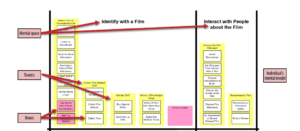Mental model is a person’s thought process on how the environment around them works. It has a psychological attachment that is built on beliefs, assumptions and perceptions. This includes past experiences of how a system functions. However, there are scenarios where some functions may not always work as expected. In this blog, we will try to understand the mental model diagram and how it can affect or change the flow of user experience or UX.
What is A Mental Model?
A mental model is a cognitive framework or internal representation that individuals create to understand and interact with the world around them. These models help people process information, make decisions, and predict outcomes. They simplify complex phenomena into understandable patterns and relationships. Mental models are built from personal experiences, education, and cultural background, and they guide perception, reasoning, and behavior.

What is the meaning of a mental model in UX?
In UX (User Experience), a mental model refers to the user’s thought process and understanding of how a system works. Designing applications and websites with mental models in mind helps create intuitive and user-friendly experiences. It takes into consideration assumptions, beliefs, and expectations that users have when interacting with a virtual interface.
Multiple industries including business and software, technology, finance and banking, FMCG goods use the mental models.
When certain instructions do not match the user’s mental model, people feel bad for making mistakes. To them, it might seem that the system is broken but this model is subject to change through different scenarios. This can also affect the perceived value.
3 Parts of The Mental Model Diagram
Users spend a lot of time browsing various websites and applications, which helps them form expectations based on familiar patterns. Their perception of your website or app depends on their experiences with other sites. Diagrams can illustrate the technical process or a more efficient workflow. If a UX designer doesn’t align with users’ mental models, new users might feel confused or lost.
There are three basic levels of the diagram.

Boxes
Boxes are building blocks that are small squares. They contain a person’s thoughts, reactions and guiding principles. Multiple boxes make up a tower. Earlier, the boxes were named as tasks but now, it indicates more of a physical action taken based on a stimulus.
Towers
Towers are a collection of multiple boxes systematically placed on top of each other as per the actions undertaken by the user. Certain actions on a particular event will translate to other corresponding actions. Multiple corresponding actions can make up a tower.
Mental spaces
Mental spaces are thought processes that people experience in a certain event. These thought processes have various stages. Example, before watching a movie, they might anticipate the event. After watching a movie, they might have a mental space where they might want to discuss the movie or explore the movie in depth.
Mental model is a collection of real world insights. It enables businesses to study a user in depth. It is akin to a user’s voice that gets captured via a diagram since it is person-focused in nature. This diagram can be applied to any situation or domain. A detailed diagram can have more advantages over a smaller diagram since a detailed perspective of a user’s insights can always help build better strategies.
Elements Of A Mental Model Diagram
While creating an informational architecture, creating a hierarchical format can be relevant. One can look at a bottom to top approach (known as a grounded process) in this structure. This ‘grounded’ structure can be summaries of how people describe their reasoning, reactions and core principles while they accomplish a purpose.
Creating a clear categorization can help designers reach a diagram that will represent people’s expectations. Website designers and application developers can use this structure to improve usability, navigation functionality, and ensure its long term success. Here are the important aspects of this diagram:
Point of view:
Point of view is the perception formed by a person that was formed by experiences, emotions and beliefs.
Structure, scope and focus:
While the structure has a certain even-based hierarchy, the scope is broad and inclusive of multiple perspectives across individuals. The main focus will consider reasons, beliefs and philosophies of users that support what the organisation has to offer.
Uses:
The main motto is to develop empathy by comprehending a person’s thought process and find opportunities for innovation based on human behaviour.
Strengths and weaknesses:
Strength:
Obtaining deep insights into a person’s thought process related to the scope of the purpose the person is trying to achieve.
Weakness:
The overwhelming details of the diagram which may also have the lack of a chronological flow.
There are two things to keep in mind while creating a hierarchy of this diagram:
1. The model testing will help you identify the models that already exist and they might correlate to each other.
2. A mental model diagram is not always fixed. However, it is continuous in terms of design. It depends on a novel stimulus or a situation. When users are acquainted with your model, they will stay in that ecosystem as long as they are meaningfully guided inside the model. When the model guidance doesn’t feel right, people might want to shift away.

How Can A Good User Experience Improve Customer Experience?
A good user experience (UX) drives a positive customer experience (CX). This process focuses on the needs, preferences, and behaviors of users when they interact with the framework. Here’s how:
- Ease of Use: A well-designed user experience ensures that the application is intuitive and easy to use. This reduces frustration, high friction points and increases satisfaction for customers who are looking for a seamless browsing experience.
- Consistency: Good UX ensures consistency across all touchpoints. This includes a website, mobile app, or a physical product. This consistency helps build trust and familiarity, where customers can feel more comfortable and confident in their interactions.
- Personalization: Effective UX design often includes personalization features that cater to individual user preferences and navigational behaviors. This makes customers feel valued and understood. This welcomes more engaging and relevant experience.
- Accessibility: A good UX takes into account the diverse needs of all users, including those with disabilities. Businesses can reach a wider audience when their interface has accessibility features too. This ensures that customers have a positive experience.
- Efficiency: A streamlined UX minimizes the time and effort required to complete tasks. From a simplified checkout process to a user-friendly navigation system, customers want the least pain points possible. The goal is to save time and reduce effort.
- Emotional Impact: A positive user experience can evoke positive emotions. Delightful interactions, such as a beautifully designed interface or a seamless user journey, can create a lasting emotional connection between the customer and the brand.
- Customer Support: Good UX often includes integrated support features like chatbots, in-app surveys, pop up surveys and an easy-to-access customer service. This proactive approach to support helps resolve issues quickly, enhancing overall customer satisfaction.
- Feedback and Improvement: UX design involves continuous improvement based on user feedback. This can be done by sharing in-app surveys, launching customer effort score surveys, conducting regular follow ups to gather more data. .
Conclusion
For any customer-centric marketing, the marketers have to be updated on how the people feel. To expedite research processes, switch to a faster way of collecting feedback from your audience. Build your Whatsapp survey in 5 minutes or create your own Facebook messenger surveys for a high response rate. Collect net promoter score, or Customer satisfaction score at ease. Sign up for a 14 day free trial with Merren and supercharge the way you collect customer feedback.
